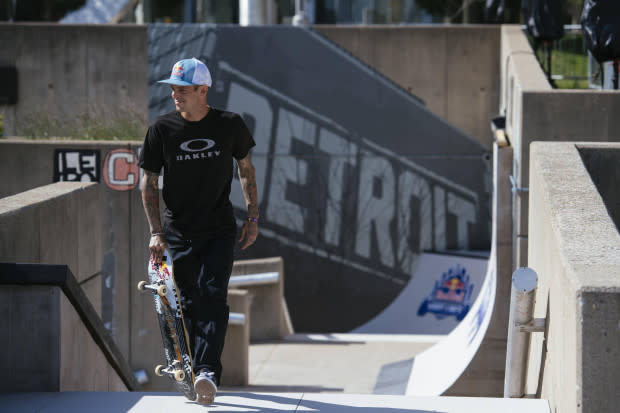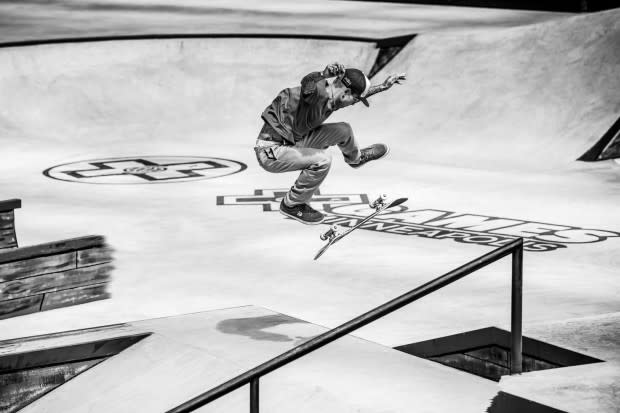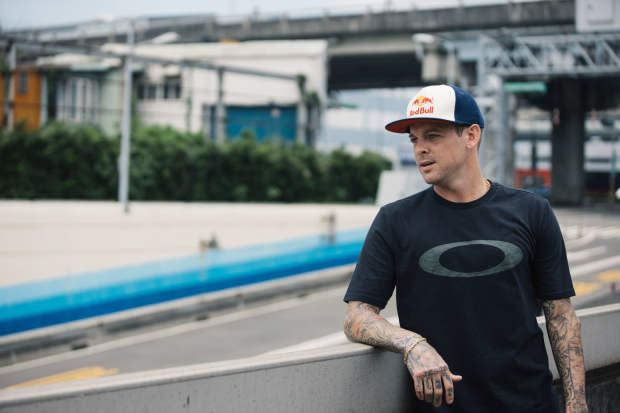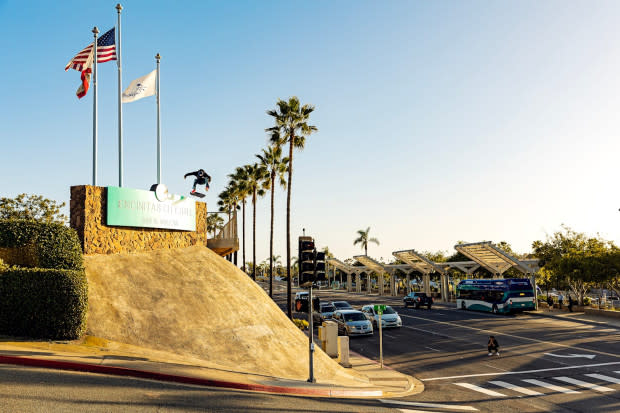Skateboard Legend Ryan Sheckler on the Slam That Made Him Question If the Risks Are Worth It
- Oops!Something went wrong.Please try again later.
Ryan Sheckler is one of the most recognizable names in skateboarding, and that’s not only because he’s a three-time gold medalist at the X Games. In an already non-traditional sport, the Orange County kid had an unwonted path to stardom. Raised in Orange County, Sheckler was scouted by skate brands and got his own MTV reality show, Life of Ryan, before he stepped into the world of competitive skating.
Despite his unique journey and early notoriety, Sheckler didn’t kick back when it came to his skateboarding career. That grind was on full display when he conquered the Costco gap with a kickflip, which was captured in an iconic photo, and dominated at the Mountain Dew Tour. That grind is still alive today, with Sheckler still attempting new tricks, but it hasn’t been without consequences. Now at 33 years old, the skater has a laundry list of injuries.
Men’s Journal spoke with Sheckler about his road to recovery, participating in the new Red Bull documentary Rolling Away, and the biggest wipeouts of his career to date.
Men's Journal: Skateboarding is synonymous with big tricks and big risks. You've suffered some serious injuries. What are some of the worst?
Ryan Sheckler: I don’t really keep a list of them to be honest, and if I try I’m sure there are a few I’m going to miss. Offhand, I broke my back, left foot, left ankle, right ankle twice, left elbow four times, right elbow three times, torn ligaments in my right foot, torn both MCLs, and torn an ACL. I have pins and screws all over my body. Not to mention the number of concussions I’ve had. I couldn't tell you how many times I’ve hit concrete from over 10 feet high. It could be close to a million times. My body has been through the wringer. It still works, but it’s been beat on.
I don’t say that to seem like a tough guy. That’s just a part of what I love to do. I’m also lucky that I haven’t had anything catastrophic happen where I can’t use my legs anymore or worse. But to do the things I’ve been able to do, I can’t think like that. I’ve never thought like that. Of course it’s always a possibility. If I have that in my mind though, it can deter me from doing what I want in the air and be thrown off course before a trick begins.

Courtesy Image
Arguably your gnarliest slam was during a live session with ETN's "Face Melters." You fractured your L1 vertebrae and broke both ankles. Walk us through that day.
I suffered that injury because I wasn’t properly prepared. More specifically, I wasn’t there physically. My mind is always ready for a challenge like that, and I was willing to go there. But my body wasn’t in the right place. I'd been skating way too much leading up to that day. I was sore all over before I even started. I knew I had to get to the bottom of that thing. The impact that I ended up taking was exactly what I could see was going to happen. There was part of my brain that already calculated all that.
This was not thinking it into existence—this was seeing all the flags and warning signs. In the car on the way there I was telling my friends that if I got to the knuckle with enough momentum, I was going to be okay. But if I fell before the knuckle, I knew it was going to be very, very bad. I knew it. And that’s exactly what happened. Looking back now, I don’t really question why it happened. That was the only fall that made me question, however slightly, what I’ve decided to do with my life. And it made me question whether or not this is worth it. The answer was yes, of course, but it was the first time I seriously asked myself that question.
Related: 50 Best Ab Exercises of All Time
What was the fallout of that crash?
I had to get surgery on my right ankle to rebuild it, and that was gnarly. I didn’t have to get surgery on my left ankle because it was just a pressure break, so that healed on its own in the cast. I didn’t know that I had broken my back until four months after I had the right ankle surgery. I thought my back was feeling tight and weird because I was in a wheelchair because of the ankles and sitting on the couch all day. I was moving around on crutches and sleeping awkward every night. Eventually I was getting this shooting pain all the way down my legs and that’s when I knew something was wrong.
I got an MRI. I saw that the top half of my L1 was in place and the bottom half was nonexistent. I actually didn’t think the photo was my back when I first saw it because it was just hanging up in the doctor’s office. I thought it was just one of the stock photos. I remember when I first saw it, I was like, “That guy’s back looks really messed up.” That’s when the doctor told me it was my back.
I told him right off that I didn’t want surgery. I’ve been lucky enough to have doctors who were familiar with athletes, and knew I was going to do what I’m passionate about regardless of what they told me. They put away the speeches about how I might not walk again. Their goal is not to stop me, but to help me do it in the best way possible.

Courtesy Image
What have you learned from those falls and injuries?
I’ve been skateboarding for so long that I can look at a jump and know whether or not it’s a good idea. I can see if it’s going to be a dangerous attempt. I didn’t care as much as I did when I was younger, partly because my bones didn’t break as easy and my ligaments were a lot more flexible. Now I’m 33. I’ve been skateboarding for 31 years and professionally for two decades. There's wisdom and intuition that comes with all of those injuries.
What achievements have meant the most to you?
Doing the Costco kickflip was huge. That was one of those moments and achievements that's unique and special still to this day. Nobody else has skated that spot like that. I’m not sure why, because it hasn’t gone anywhere. I never could have known that place and that trick would be such a big part of my journey but it is. The tail drop kickflip at Encinitas City Hall more recently was very special. It was a true mental battle.
As epic and monumental as these tricks have been for me, I don’t know if they’ve really changed the face of skateboarding. But that’s never been my goal or my drive. I’m not looking to take on the world of skateboarding or the world of sports in general. I’ve always been battling against myself. Nobody was forcing me to do these things when I was younger, and there were no rewards. Later on, nobody was forcing me to compete. I’m just in love with skateboarding and I’m obsessed with that feeling of conquering something scary and the adrenaline that comes with the experience.

Courtesy Image
Can you put that feeling into words? What's happening in your mind and body?
I think I’m most addicted to the level of focus I have before and during a trick. I get more focused the more dangerous something is or if it’s never been done before. I'm more focused than I am in any other time in my daily life. I get this tunnel vision and time truly slows down and it's felt in every fiber of my being. I can feel the wind and the elements around me to a level I can’t even explain. I feel like I’m actually one with whatever I’m skating. And that's a feeling I’ve become addicted to.
Related: How to Overcome Fear: Alex Honnold, Lindsey Vonn & More
What do you struggle most with?
I’d say in general I don’t know how to go slow. My speed has always been full-on or nothing. I think that’s a big reason why I’ve had so many injuries. I know that’s also why I struggled with alcohol and why I was an alcoholic. That same obsession is why I train so hard in the gym as well. If I’m going to the gym, I’m going in there to be the strongest, whether that’s possible or not.
Why do you think you've gotten so much hate over the years?
There were a lot of haters. I was getting hate for being a “contest winner” like that was a bad thing. Personally, I was there to win every time. So if I had to put in the work off the skateboard to win, I was going to do that. The love-hate relationship the skateboarding community has had with me is insane. I’m at a position now though where I’m very comfortable with what I’m doing. I skateboard, and I’ve made decisions that people don’t agree with, but that doesn’t really affect me. There are a lot of people who have made bad choices in their life, but I’m just easier to latch on than others apparently.
Now everybody has a coach, a nutritionist, and a personal trainer. Everybody is trying to make it into the Olympics and compete to that level. It’s all become the standard. That’s why we’re seeing this level of competition and the level of ability skateboarding today. Not just because of the workouts, but because the mindset. The concept that this is something worth training hard for, and not just when you have a skateboard below you. Everyone else realized that focusing on being better every second of the day can get you that inch. I’m glad skateboarding is at this point now.
How do you prepare for a new trick?
I’ve always put a lot of work into preparing for competitions. I’m big into visualization. I would always get the courses early and study them intensely. The X Games are always special, because the competition is taken more seriously. In the beginning I was intimidated by it, these one-minute runs that we’re doing. But my dad used to say, “You can do anything for 60 seconds.” I needed to hear that sometimes because I was too deep in my own head and had this defeated mentality. I stopped thinking about those competitions and challenges as these make-or-break moments, and instead thought of them in the sense of seconds. That freed me to go for it, and take myself to the limit because it was stripped of that gravity.

Courtesy Image
Outside of competitions, how much do you practice and attempt a jump before you finally land it?
Tricks can take months or even years to happen after I’ve thought about it. Recently there was this big frontside flip up this gap. I ended up having to go to that spot three different times. There was a lot of work that went into that trick. I couldn’t figure out the speed and I couldn’t figure out the flick. I ended up recreating that spot at my skatepark. I would only work on that one trick for my entire session. I was doing frontside flips for a week straight to the point where I was dreaming about frontside flips.
The same process was done for the tail drop kickflip. I would go higher and higher each time. I was thinking about that kickflip for three years. I did five different trips to it and took over 60 falls down that bank. I landed the fifteenth attempt on the fifth day. I had to go through hell to get that one. For the frontside flip it took me around 30 tries during one day to finally nail it. But thanks to that training, I knew what it felt to land these tricks, so when I felt the familiar movement in the air, it was over.
Related: 35 Books Every Man Should Read in His Lifetime
The Red Bull doc Rolling Away gives us a glimpse into that process, which is fun to see. What made you open to doing a project like this?
I was actually adamant on not doing a documentary at first, because I don’t believe my story is finished. My story's not done. I always saw documentaries as these things that signal you're on your way out. That’s not the case for me. God willing I have more that I’m going to do. There’s been a lot of craziness in my life. We decided to switch the narrative of the documentary, to make it about the obsession of skateboarding. That makes more sense for where I am right now.
I honestly don’t know if it would have come together like it did if I hadn’t torn my ACL three months into filming the project. Because we were put in that situation, we made the decision to film my recovery process as well. I wanted to show anyone who competes, or even if they don’t, what the recovery process looks like. I wanted to show people that you can come back—and come back strong. I’m really proud of how it came out.
Check out “Rolling Away” and “Lifer” on Red Bull Skateboarding YouTube.
